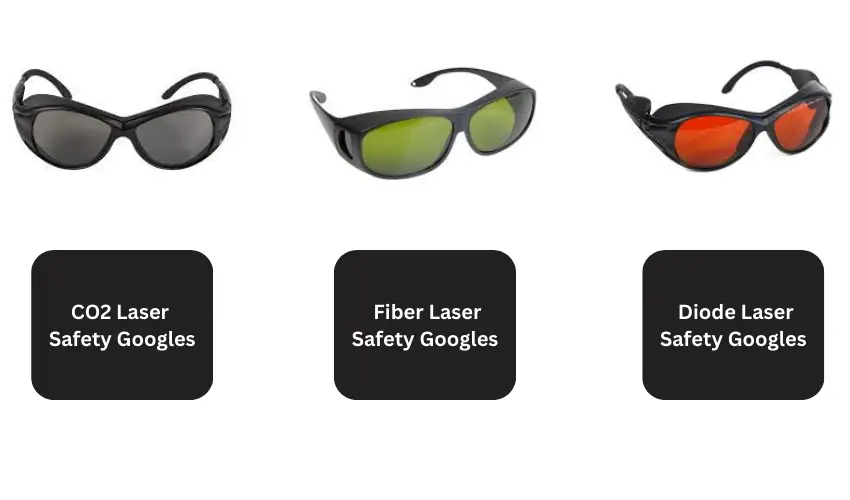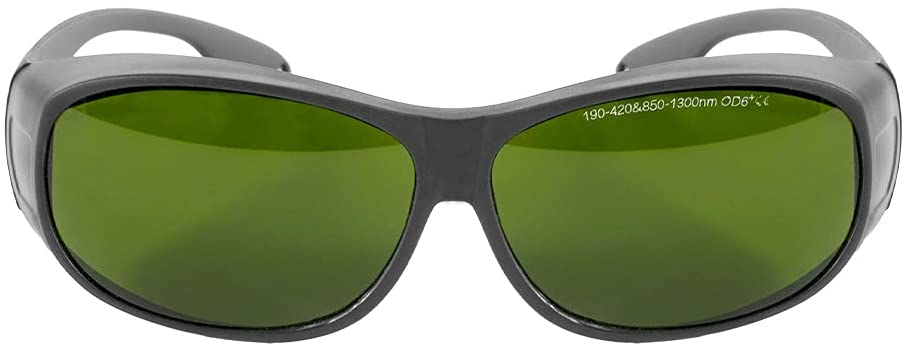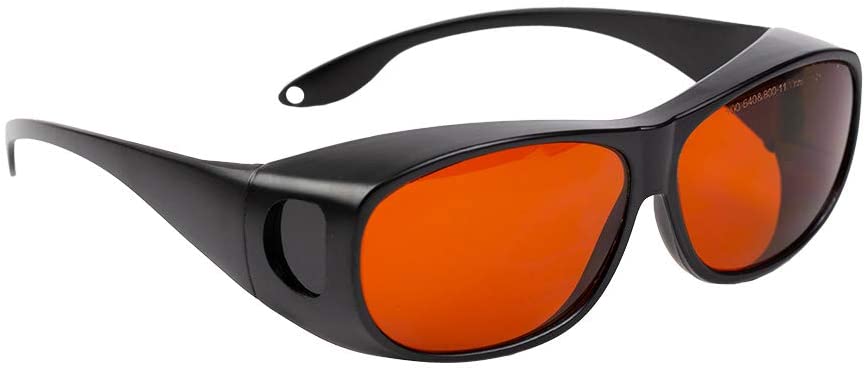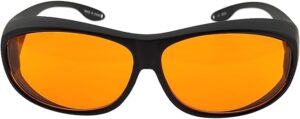This article deals with crucial aspects of eye protection for laser engraving processes. It outlines the types of laser safety eyewear available, their specific functions, and how to choose the right protection based on the wavelength of the laser used.
Additionally, it covers safety standards and regulations, proper maintenance of protective eyewear, and common pitfalls to avoid. Whether you’re a professional engraver or a hobbyist, this guide provides essential information to ensure your eyes are adequately protected from the potential hazards of laser engraving.
Table of Contents
Is laser engraving eye protection really necessary?
Yes, laser engraving eye protection is essential. Laser engravers emit intense light that can be harmful to your eyes, even if you don’t immediately feel discomfort. The risks include potential damage to the retina and cornea, which can lead to serious vision problems. Here’s why protection is crucial:
- Intensity of Laser Light: Laser engravers produce concentrated beams of light that can cause eye injuries. Even brief exposure can be dangerous, depending on the laser’s power and wavelength.
- Wavelength-Specific Protection: Different lasers operate at different wavelengths, so the protective eyewear must be designed to block the specific wavelengths emitted by your laser engraver.
- Accidental Exposure: Eye protection helps guard against accidental reflections or scattered laser light that might not be immediately visible but can still cause harm.
- Long-Term Safety: Regular use of proper eye protection reduces the risk of long-term damage, which might not be immediately apparent but can have serious consequences over time.
Investing in high-quality, appropriately rated laser safety glasses is a key step in ensuring your safety while working with laser engraving equipment.

Common Laser Types and Their Wavelengths
Determine the wavelength of the laser used in your engraver. Choose eyewear that is specifically designed to filter out these wavelengths. Here are the typical wavelengths for each of the most common lasers:
- CO2 Laser:
- Wavelength: 10,600 nm (10.6 µm)
- Fiber Laser:
- Wavelength: Typically between 1,030 nm and 1,100 nm (near-infrared), with common wavelengths around 1,064 nm.
- NdLaser (Neodymium-doped Yttrium Aluminum Garnet):
- Wavelength: 1,064 nm (infrared)
- UV Laser:
- Wavelength: Common wavelengths include 355 nm (near-UV) and 266 nm (deep UV).
- Green Laser:
- Wavelength: 532 nm
- Blue Light Diode Laser:
- Wavelength: Typically ranges from 405 nm to 808 nm.
These wavelengths determine the laser’s interaction with different materials and its suitability for various applications.
Choosing the Right Laser Engraving Eye Protection
1. Understand the Wavelength: Determine the wavelength of the laser used in your engraver. Common wavelengths for laser engravers include 10600nm for CO2 lasers, 1064nm for Ndlasers, and various wavelengths for UV or fiber lasers. Choose eyewear that is specifically designed to filter out these wavelengths.
2. Optical Density (OD): Look for glasses with the appropriate Optical Density rating for your laser’s wavelength. The OD rating indicates how effectively the eyewear attenuates laser light. For example, a higher OD rating provides greater protection.
3. Certification and Standards: Ensure the eyewear complies with safety standards and certifications such as ANSI Z136.1 (U.S.) or CE (European Union). These certifications ensure the eyewear meets rigorous safety and performance criteria.
4. Comfort and Fit: Since you may wear the glasses for extended periods, comfort is crucial. Choose glasses with an adjustable strap and a design that fits your face well without causing discomfort or obstructing your vision.
5. Lens Quality: High-quality lenses are essential for maintaining clear visibility while providing protection. Poorly made lenses can distort vision or reduce the effectiveness of the eyewear.
Maintenance and Care
1. Regular Inspection: Regularly inspect your safety glasses for any damage or wear and tear. Replace any scratched or damaged lenses immediately to ensure continued protection.
2. Cleaning: Clean the lenses with a soft, lint-free cloth and a gentle lens cleaner to avoid scratching. Avoid abrasive materials or harsh chemicals that could damage the protective coating.
3. Storage: Store the glasses in a protective case when not in use to prevent damage from accidental impacts or scratches.
Common Pitfalls to Avoid
1. Using Incorrect Eyewear: Do not use general-purpose safety glasses or sunglasses, as they are not designed to protect against laser wavelengths. Always use eyewear specifically rated for laser protection.
2. Overlooking Wavelengths: Ensure the glasses match the specific wavelength of your laser. Using incorrect eyewear can lead to insufficient protection and increased risk of eye damage.
3. Ignoring Regulations: Follow all safety regulations and guidelines for laser use in your area. Compliance helps ensure that you and others are adequately protected while using laser engraving equipment.
Below you will find the best types of laser engraving eye protection safety glasses available and their specific functions.
Best CO2 Laser Engraver & Cutter Safety Goggles
Cloudray CO2 Laser Safety Glasses, 10600nm, OD: 6+
The Cloudray CO2 Laser Safety Glasses are designed to offer robust eye protection for users of CO2 laser engravers and cutters operating at a wavelength of 10600nm. Here’s an in-depth look at their performance:
Pros:
- Effective Protection: These glasses provide effective protection against the 10600nm wavelength emitted by CO2 lasers, significantly reducing the risk of eye damage from laser exposure.
- Comfortable Fit: The goggles are designed with an adjustable strap and a contoured frame, ensuring a snug yet comfortable fit for prolonged use.
- High-Quality Optics: The lenses are made from high-quality optical materials, offering clear visibility while maintaining safety standards. The clarity of the lenses helps in maintaining focus and precision during engraving tasks.
- Durable Construction: Built to withstand regular use in various working environments, these goggles feature a sturdy frame and impact-resistant lenses.
- Professional Grade: These goggles are specifically tailored for professionals working with CO2 lasers, ensuring they meet rigorous safety standards.
Cons:
- Limited Use for Other Wavelengths: These glasses are designed exclusively for the 10600nm wavelength. They may not offer protection for lasers operating at different wavelengths, limiting their versatility.
- Bulkiness: The goggles can feel bulky for some users, potentially affecting comfort and mobility during extended periods of use.
- Fogging Issues: Some users might experience lens fogging during intense work sessions, which could hinder visibility and safety.
Overall: The Cloudray CO2 Laser Safety Glasses (Style C) are a solid choice for anyone using CO2 laser equipment. They offer excellent protection, comfort, and durability, making them a reliable option for professional use. However, their specialized nature might be a consideration for those needing multi-wavelength protection.
Best Fiber Laser Engraver Safety Goggles
Cloudray Fiber Laser Safety Glasses, 1064nm, OD: 6+
The Cloudray CE 1064nm Laser Safety Goggles are designed to provide high-level laser engraving eye protection for users of YAG, DPSS, and fiber lasers operating at a wavelength of 1064nm. Here’s a comprehensive review of their features:
Pros:
- Specialized Protection: These goggles offer effective protection for 1064nm, 1070nm, 1080nm and 1100nm lasers, ensuring that users are shielded from potentially harmful laser radiation.
- Convenient Storage: The robust protective case provides secure and convenient storage for your valuable laser engraving eye protection goggles.
- Clear Visibility: Equipped with high-quality optical lenses, these goggles maintain clear visibility, which is essential for precise work and accurate laser operation.
- Durable Build: The robust construction of the goggles ensures they can withstand the rigors of regular use, making them a reliable choice for professional environments.
- CE Certification: The goggles meet CE safety standards, which adds a layer of assurance regarding their quality and effectiveness in protecting against laser exposure.
Cons:
- Limited to 1064nm – 1100nm Wavelength: These goggles are designed for 1064nm – 1100nm lasers. They are not suitable for lasers with different wavelengths, which limits their versatility.
- Bulkiness: Some users might find the goggles a bit bulky, which could affect comfort and ease of movement during extended use.
- Potential Fogging: In certain conditions, the goggles may experience lens fogging, which can interfere with visibility and overall safety during laser operations.
Overall: The Cloudray CE 1064nm Laser Safety Goggles provide targeted protection for lasers operating at 1064nm – 1100nm, offering a blend of comfort, durability, and clarity. They are a solid choice for professionals working with YAG, DPSS, and fiber lasers. However, their specific wavelength focus may be a consideration for those needing a more versatile option.
Best UV & Green Laser Safety Goggles
Cloudray UV & Green Laser Safety Glasses, 355 & 532nm, OD: 4+
The Cloudray 355 & 532nm Laser Goggles are designed to offer laser engraving eye protection for users of UV and green lasers operating at wavelengths of 355nm and 532nm. Here’s a detailed look at their features:
Pros:
- Dual Wavelength Protection: These goggles provide effective shielding against both 355nm UV and 532nm green lasers, making them versatile for various laser applications.
- Compact Design: The small size of the goggles ensures a snug fit and enhances comfort, especially for users who prefer a more streamlined eyewear option.
- High Optical Clarity: The goggles feature high-quality optical lenses that maintain clear visibility, which is crucial for precision work and ensuring safety while operating lasers.
- Durable Construction: Built with robust materials, these goggles are designed to withstand regular use and protect against laser radiation effectively.
- Affordably Priced: Compared to some specialized laser safety eyewear, these goggles offer a good balance between quality and cost, making them accessible for various users.
Cons:
- Limited to Specific Wavelengths: While they are effective for 355nm and 532nm lasers, they do not provide protection for lasers operating at other wavelengths, which may limit their versatility.
- Fit and Comfort: Although compact, some users may find the goggles less comfortable for prolonged use, especially if they have a larger face or wear corrective lenses.
- Potential Fogging: Like many protective eyewear options, these goggles may experience fogging during intense work sessions, which can impact visibility.
- Less Coverage: The small size may offer less coverage compared to larger goggles, which could be a concern for users needing extra protection around the eyes.
Overall: The Cloudray 355 & 532nm Laser Goggles are a practical choice for those needing laser engraving eye protection from UV and green lasers. They offer effective shielding, high optical clarity, and a compact, cost-effective design. However, their specific wavelength focus and potential comfort issues might be considerations for users with different needs or preferences.
Best Diode Laser Engraver Safety Goggles
Laserland Blue Light Diode Laser Safety Glasses, 405nm, 445nm, 450nm, 473nm, OD: 6+
The Laserland OD6 Laser Safety Glasses are designed to offer laser engraving eye protection for users working with lasers emitting in the Blue Light Diode and UV visible spectrum, particularly those operating at wavelengths such as 405nm, 445nm, 450nm, and 473nm. Here’s a detailed review of their features:
Pros:
- Broad Wavelength Coverage: These glasses provide protection across a wide range of wavelengths from 190nm to 490nm, making them suitable for UV and various visible lasers including blue light diode, and green lasers.
- High Optical Density: The OD6 rating indicates a high level of attenuation, ensuring effective protection against laser radiation and minimizing the risk of eye damage.
- Comfortable Fit: These glasses offer a comfortable fit, making them suitable for extended periods of use.
- Clear Lenses: The optical quality of the lenses maintains clarity while offering protection, allowing users to work with precision without significant distortion or color shift.
- Versatile Protection: The glasses are versatile and can be used for a range of laser applications, including industrial, medical, and research environments.
Cons:
- Specialized Use: While the glasses cover a broad range of wavelengths, they are specialized for specific wavelengths and may not be suitable for lasers outside the 190nm to 490nm range.
- Fit and Style: The design might not fit all face shapes comfortably, and users with larger faces or those wearing corrective lenses might find the fit less ideal.
- Potential Color Distortion: Although the glasses are designed to offer protection, some users might experience slight color distortion or reduced visibility, which could impact tasks requiring precise color differentiation.
Overall: The Laserland OD6 Laser Safety Glasses are a solid choice for those needing laser engraving eye protection across a broad range of UV and visible wavelengths. They offer high optical density, comfort, and clarity, making them suitable for a variety of laser applications. However, their specialized nature might be a consideration for users with different needs.
The United States Occupational Safety and Health Administration is serious about protecting American citizens from the effects of laser exposure. As a result, they require anyone operating a class 3b and Class 4 laser engravers to wear safety glasses.
Laser safety eyewear comes in different wavelengths suited for different types of lasers. You should, therefore, take the wavelength of the laser beam into account when purchasing your safety goggles.
How laser radiation affects the eye

The human eye is extremely sensitive to any type of laser radiation. Here is how laser radiation can affect the retina, the cornea, and the lens.
- The retina: the retina is a thin layer of tissue located at the back of the eye, adjacent to the optical nerve. Its work is to receive focused light, convert it to neural signals, and send them to the brain for visual recognition. Visible laser light of wavelengths between 400 and 1,400 nm can cause damage to the retina.
These wavelengths are scientifically referred to as the retinal hazard region. Visible laser light focused on the retina by the lens is concentrated on the exposure of up to 10,000 times. This can easily damage the tissues of the retina which unfortunately don’t regenerate. What this means is that retinal damage, especially that of the central portion, fovea, and macula, is permanent. - Cornea and lens: The cornea of the eye transmits visible light to the lens which in turn, focuses it on the retina. Because of the roles these two play in the eye, they too, suffer eye damage when they come face to face with harmful laser beams. This can be through photochemical damage (denaturing of proteins) or thermal damage (caused by heating or burning of the tissue water and tears of the cornea or lens).
Types of laser radiations
Laser radiation can either be direct, reflected or scattered. Each of these affects you in a different way. Let’s briefly go over each of them:
- Direct radiation: this is contact with a beam emanating directly from a laser source. This type of optical radiation can either be visible or invisible and can burn or denature proteins in the eye region. It can also lead to photochemical reactions in the eye tissues, depending on the wavelength of the radiation.
- Indirect/reflected radiation: this refers to a laser light that originates from a reflected beam. Even if the beam is oriented to a specific workpiece, the reflected light energy can cause some harm. Expectedly, this carries a fraction of the energy dissipated by direct light but it can still damage your eyes.
- Scattered radiation: scattered light has a number of similarities with reflected light except that it originates from a diffuse surface rather than a reflected one. A perfect example is if you walked into a dark room and turned on your flashlight. The light from the flashlight will instantly brighten the room. Because the scattered light beam is reflected in numerous directions, it doesn’t carry as much energy as the preceding types. But scattered radiation is still harmful to the unprotected eye.
Factors affecting the extent of eye damage when exposed to a laser radiation
When the eye is directly or indirectly exposed to a laser light beam, it can suffer temporary or permanent damage depending on several factors:
- The wavelength of laser radiation
The most important factor is the wavelength of light energy. Typically, exposure to laser radiation of wavelengths of less than 400 nanometers and more than 1400 nanometers causes cataracts and burn injuries.
The reason is that the cornea and lens of your eyes absorb the light energy and heats them up. Depending on the focus of the retina radiation, the damage will be varied. An eye injury to the fovea may lead to permanent blindness while an injury to the peripheral areas of the fovea is less severe.
- Laser power
Expectedly, the higher the laser power, the worse the level of eye damage. Blinking may not do much at this stage. Anything more than 10-20 milliwatts for wave lasers causes retinal damage in case of a direct hit. If you stared straight into a laser, the burn will be right at the center of your vision. In severe cases, you could lose your central vision and experience permanent blindness.
- Distance from the laser source
Another factor affecting how much eyes get damaged from laser radiation is the distance between your eyes and the source of the laser beam. The further away you are from the laser source, the less severe the eye damage. Even with the same wavelength, a laser beam that can instantly damage the retina at close range does little harm to someone observing it from a long distance away.
Conclusion
Laser engraving presents significant risks to eye safety, making proper eye protection an absolute necessity. By choosing eyewear designed for your specific laser’s wavelength, understanding Optical Density ratings, and ensuring compliance with safety standards, you can protect your eyes from potential harm.
Regular maintenance and careful attention to the type of protective eyewear you use will help ensure a safe and productive engraving experience.




